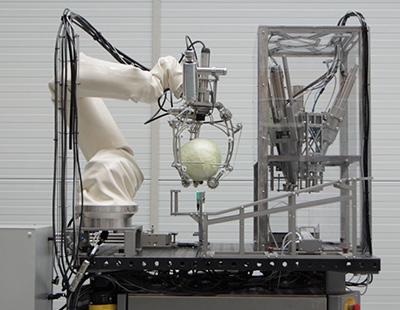
4 minute read
Digitalisation as a lever for the green transition
Vision and artificial intelligence reduce food waste
Automation in the food industry can help to make the management of food more productive, reduce food waste and relieve employees of hard manual tasks.
At Daloon, cabbages are used to make spring rolls - but as the cabbages vary in size, diameter and shape, it is difficult to make a machine that can handle them. Therefore, the system integrator Technicon has worked together with Danish Technological Institute to develop a prototype of a robotic solution under the auspices of the EU project called agROBOfood.
The solution uses cameras and artificial intelligence to find the cabbage and its stem. By visually identifying each head of cabbage, data is gained on its diameter and the size of the stem. This data can be passed on to the boring machine, which then removes the stem precisely. This significantly reduces the waste produced during the process.
”Danish Technological Institute and Technicon have really come up with some great inputs here, and this has helped all of us do better. It has allowed us to manage our food items much more
precisely.” - Peter Madsen, CTO at Daloon
AgROBOfood is financed by the EU’s Horizon 2020 programme and is intended to promote the use of robotics in the food industry.
Growth in the agroindustry - powered by data
We help the agroindustry optimise processes and use data to design better products, predict errors and replacements needed or to show the climate impacts from production processes. Through intensive development processes, the Institute makes our competences in working with digital business models, artificial intelligence, machine learning and data mining available to companies. Together with the company One2Feed, we have worked on optimising the utilisation of available data from cameras in their automatic fodder units for dairy farmers.
”It is no doubt the access to expert knowledge that has taken us a long way along our digital journey in a
short period of time. ” - Jesper Scriver, Sales and Support, One2Feed
“Growth in the agroindustry - powered by data” is a new project supported by the Danish Industry Foundation. The project is a collaboration between Aarhus University, Dansk Agroindustri, SEGES Innovation and Danish Technological Institute.
In the Institute’s new and advanced interior climate laboratory, we develop and test technologies for the heating, ventilation and cooling of buildings.
The laboratory can automatically model and set the dimensions of a room. At the same time, we can stipulate factors such as sunlight, cold and heat from humans that impact the interior climate in buildings.
The interior climate laboratory’s data platform collects and analyses data on the function, operating conditions, services and interior climate impact of the interior climate technologies. A digital ‘twin’ also ensures that the testing and development tasks can easily be monitored on a screen. Together with Airmaster A/S, we are working on developing an intelligent, energyefficient and adaptive control system for a heat pump-driven ventilation unit. The unit is controlled based on algorithms that adjust and optimise the interior climate to match current and projected use of the building and interior climate.
The use of artificial intelligence with Model Predictive Control is to ensure that the developed ventilation unit can adjust its services to the actual need for ventilation, heating and cooling based on the desired interior climate.
The “Development of an intelligent, energy-efficient and adaptive control mechanism for a heat pump-driven ventilation unit” project is funded by Elforsk. The participants in the project are Airmaster and Danish Technological Institute.

Drones are to extend the life of the Great Belt Bridge
Drones, sensors and artificial intelligence can become the eyes and hands that will make the Great Belt Bridge outlive most of us.
We are developing the drone technology to be able to spot cracks and to determine how deep they are. This is done by the drone attaching itself to the bridge and using a robotic arm to inspect the depth of the crack using ultrasound sensors. Advanced software and algorithms assist the drone in identifying the crack, positioning itself correctly by the crack and taking measurements in the correct locations.
One of the advantages of using drones to investigate cracks is that they are discovered before they become so serious that major repairs are needed.
The project is called DroneDeploy and is a Odense Robotics collaboration with Sund & Bælt, Danish Technological Institute, Technical University of Denmark, Dansk Drone Netværk and Senseable.
”It is projected that the bridge will remain usable for about 100 years. However, we are aiming for 200 years. Specifically, those 100 additional years will
save an additional 750,000 tonnes of CO2. - Finn Bormlund, Project Manager at Sund & Bælt ”









